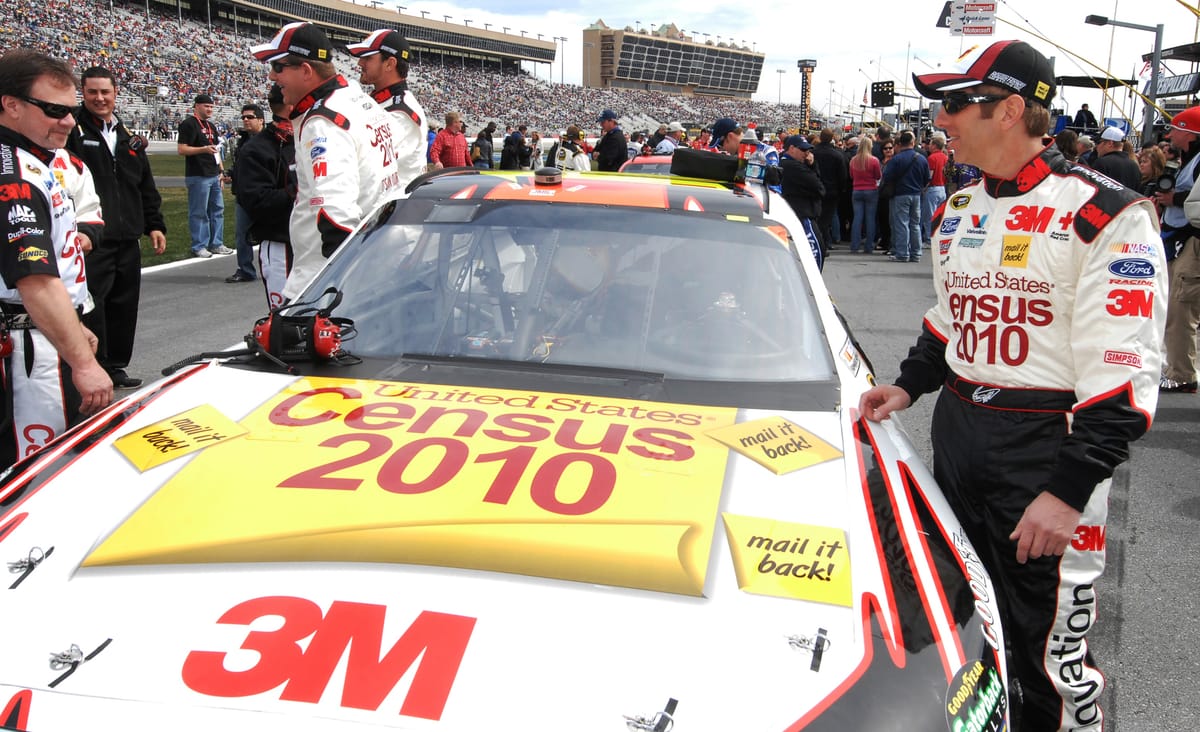Industry Knows Best, Anecdote 1: Mobile Vehicle Units

I recently told a small group of folks this story, quasi-publicly, for the first time. But I had to do it in 5 minutes. You lose a lot of the flair with that kind of time constraint. So here's the whole thing.
All thoughts, opinions, and other words here are exclusively the personal opinions of the author and do not express any official position, statement, or other communication from or on the behalf of the U.S. government. This is a work of fiction. Any resemblance to actual persons, living or dead or actual events is purely coincidental.
I'm not a NASCAR fan. I am a fan of its origins though. But I don't watch the races or anything. Despite my abstinence, it's apparently very popular.

At what I thought would be just another Decennial Bi-Weekly Acquisition Planning meeting, and I came to learn these were almost never predictable, the discussion took a strange turn...
Scott (not their name but apparently a good way to know who is the worst NASCAR driver, I dunno I don't watch it): I was watching the race this weekend. And it's so cool how they have their mobile command center for each team.
Me: (silent wondering where this is going)
Scott: I think there's a real opportunity here for 2020 cost savings. We shouldn't lease commercial real estate, we should get a fleet of those.
Me and several other people at the same time: What?
Before the reorg that destroyed the regions, and their offices, because if you play the Game of Thrones you either win or you die, we would have to rent a lot of physical space for Decennial operations.
In fact, we would have a local census office (LCO) that corresponded to every elected member of the House of Representatives. That was not a coincidence. The Legislative branch often had opinions, both good and bad, on how and where we should spend Census money to best benefit their specific districts, which is how we got the National Processing Center (NPC) in Jeffersonville, Indiana facility (Census people call it Jville). Congress always thinks if an agency does spend money, even the ones against it, then it should be in their districts and states.
For 2020, we estimated that we would need about 2 million square feet of commercial real estate during ramp up, enumeration–which is what we called counting people–and then ramping down of activities.
But Scott had other concepts of a plan.
Scott was a new "industry hire" as a GS-15 engineer. Typically, "industry hires" are seen as more valuable than just some jerk who worked their way up from the mailroom, like they did in the old days. This is doubled by the fact he was an "engineer."
"Industry" or "private sector" is a short hand in this shadow world that you'll see and hear frequently. It indicates that someone who has it is "faster, better, smarter" than a govie. If you don't believe me, just watch a circuit event and listen for how it gets used and comes up in conversation.
Unfortunately, this meant that he held enough of a sway that this was going to be my problem now.
Like those Chinese made iPhones.
Scott: We can build a fleet of those NASCAR rigs and save money on brick and mortar. Let's start looking into that.
Me: *blinks*
You may be wondering why I thought this was not a great idea. If that's the case, this is going to be a lesson in infrastructure costs.
Like the time I came up with a proper government cost estimate for exactly how you could budget and buy a moat that went across the entire U.S. Mexico border and fill it with "man eating" alligators as an illegal immigration deterrent. I did it on Twitter and rather than replicate it again, see a fav author of mine P.W. Singer's version (mine included actual GSA Schedule links where you can buy alligators).
For several months, Scott started to advocate and rally support across disconnected, disinterested leadership who could approve the idea. Maybe it wouldn't have gotten anywhere. But I had seen plenty of instances where someone saying "let's buy a thing" developed enough momentum that we would end up actually buying it. Whether it was a good idea or not.
It didn't help that Scott reported to Patrick Bateman's Hatchet Man and they were simpatico. I tried to dissuade him diplomatically by having someone else try.
Census is filled with people who are well versed experts in the esoteric art from Arabia known as arithmetic. We also have a bunch of economists hanging around.
In addition to Decennial, Field, and IT, I also supported the Research and Methodology (R&M) Directorate because I was one of the only 1102's who could talk to the "mathstats," the technical core competency of Census. Sometimes they could be a bit bristly or odd, but I grew up on a university campus so it was nothing out of the ordinary for me.
I found one who wasn't too busy to come to a Decennial Bi-Weekly Acquisition Planning meeting. He was thrilled.
Usually, the economists were kept behind a locked, steel door in the building like it was a Secure Compartmentalized Information Facility (SCIF).
He enthusiastically came along, excited at the chance to offer his expertise if it helped. I think he ended up regretting it.
Me: Scott could you walk Bob the Economist here through your concept of operations for the MVUs?
(MVU = mobile vehicle unit which is what Scott was referring to his idea as now when he briefed it around).
Scott: Explains how building out a custom fleet of hundreds of different sized mobile vehicles would save money compared to temporarily leasing real estate.
Bob's enthusiasm quickly turned into abject horror as he realized this was serious. The look on his face is still etched in my mind, Census 2010 lanyard dangling around his neck with his PIV card on it.
Bob: I don't think this is a viable solution.
Scott: I think it's doable.
Bob: What about the costs for drivers?
Scott: We'll have to cut a driver contract or something.
Me: (takes notes very exaggerated to make sure Scott sees me being attentive).
Bob: What about maintenance costs for each of the vehicles? Gas, tires, parts, etc.?
Scott: Well obviously we'll have a maintenance contract or something, maybe we can bundle it with the drivers.
Bob: What about parking? You can't expect to drive them continuously, they'll have to be parked for the work day.
Scott: Good point, we'll need to cut a parking contract or something. Maybe we can just use Wal-Marts.
Bob: What about restrooms?!
Scott: Well they can use the Wal-Mart where they're parked.
Bob: What if there isn't a Wal-Mart?!
Scott: Well...I guess we can just get a port-a-potty or drive to the nearest bathroom or something. Or we'll put a bathroom in the tractor trailer. I wonder if it'll have to be Ada (Americans with Disabilities Act) compliant or we can just get a pass on reasonable accommodation by driving them somewhere that has a handicap stall.
Rather than reveal to Scott that I thought he was a deranged lunatic, and he was, I studiously took notes. Remember, I would bring a federal prisoner made pad of paper and pen, well the pens were all from Skillcraft, as a prop for just such an occasion. Sometimes it helps to performatively look busy and responsive.
This was also a valuable lesson in how people's education and experience can affect how they navigate the world around them. Scott was an "engineer." Rather than stop to ask if he should, he only cared if he could. Each potential issue was not a blocker, just an engineering issue. A problem that could be solved. It'd be admirable if it wasn't so blatantly stupid.
Nevermind that his solution for each one wasn't actually based in engineering but just seemed to be me spending more money through contracting actions. This is a recurring theme in my career. People from other fields claiming they know what to do, and then using contracting rather than their own discipline to accomplish it.

My supervisor and I watched for a half hour as Bob would raise a cost implication for the MVU concept and Scott would dismiss it as if it were an issue about iPhone colors. Bob's points were easily resolved because the concept of the plan was sound.
Rather than have any doubts, Scott viewed this as a great, useful conversation for more contracting actions to add to the inventory. In fact, he gave me kudos for setting up. Bob had fleshed out great operational gaps we'd have to fill...with money. Piles and piles of money.
Now the MVU's wouldn't just be office spaces. They also would be fully network enabled and built out so that we could separately, and securely, relay sensitive "Title Data" through our own pipes. "Title Data" refers to data that Census collected per Title 13 of the U.S. Code.
He didn't mention it outright, but I sometimes wondered if, in addition to NASCAR, Scott thought that the villain's custom tractor trailer rig in the 2007 movie Live Free or Die Hard was badass.
Shoving extensive amounts of IT infrastructure into every nook and cranny of these suckers significantly increased the price per MVU.
Then someone else, who had also been promoted recently to being a GS-15, decided they could make a bad idea worse at another Decennial Bi-Weekly Acquisition Planning meeting.
Lunatic: We've never explored the option of enforcing Section 221, we could put a holding cell in Scott's MVU.
Everyone: What?
Section 221 of Title 13, is a part of the U.S. Code that covers Census.
Section 221 actually allows Census to fine individuals $500 or less if they don't answer the survey. It does not allow for jail time and we explained that to him.
The reason we have never, ever enforced Section 221 against an individual, or even mentioned it, was that it would have a devastating chilling effect on voluntary response. Like when a member of Congress repeatedly tells constituents not to fill out the Census when we visited them.
For several months, my supervisor kept an aspirational diagram of the to-be MVU with all of the features added onto it on his office white board. After that meeting, he added a little jail cell.
At one point that same lunatic, and I'm not joking here, thought we should incorporate drones into 2020, after watching the movie Minority Report. Because he said, I was watching Minority Report this weekend...
This was suggested in the year 2013. As I write this, it is 2025. And in 2025, neither drones, nor technology generally, have advanced to the point where little spider robots can find people in buildings and scan their retinas.
But my supervisor added a rack of aerial drones to his diagram on his office white board.

If you think that this is just a joke, think again. Because something eerily similar happened over the course of decades with one of my favorite military acquisition boondoggles, the Bradley Fighting Vehicle.
Please watch this whole clip. This is completely accurate to what happened. It's bananas. B-A-N-A-N-A-S. You should also watch the movie Pentagon Wars or read the book it's based on.
Since this wasn't going away, I went and did market research because these things actually do exist but–like the Bradley–but they're usually in the law enforcement/military space.

I started to go up to these whenever I saw them around, like at the gas station with my family waiting for me to finish, which isn't difficult in the D.C. metro area. I spoke with the cops or soldiers using them like I was shopping for a new car and they had the very make and model that I wanted to test drive.
It probably got added to my FBI file. I know I actually have an "FBI file" since I've done work for them (another story).
Now there is one civilian agency who has a similar, much much smaller, fleet that Scott envisioned for 2020.
The Federal Emergency Management Agency (FEMA), formerly the Office of Civil Defense–the fine folks behind Bert the Turtle who taught kids that "duck and cover" would save them from nuclear apocalypse, has a fleet of kitted out, large vehicles.

I called up FEMA and talked to them about what we were doing. FEMA was incredulous about how this was going to be cost effective for us, but were happy to share with fellow govies. FEMA's fleet has a legitimate purpose, because if there's a tornado, or hurricane, or wildfire, then it's not just homes and businesses that are destroyed but basic infrastructure. FEMA's fleet can provide communication, power, and more to affected populations and staff.



Now what the link I shared doesn't say, and what you won't find on the internet, is that the Green Hornet, rightly, cost several million dollars to build. It's the one that FEMA actually bought. They have 2 of these, but the first one they got is called the "Red October" and they inherited that one from the Drug Enforcement Agency (DEA).
DEA seized it from a drug cartel who used it to smuggle drugs over the border. After the seizure, during a research trip with the DEA for one of his male romance novels, the author Tom Clancy noticed the interior had red lights, because it was for smuggling, and said it reminded him of his book The Hunt for Red October. The name stuck.
So I had Scott join a call with the FEMA as they went over the logistics of building out and maintaining the Mobile Emergency Resource Support (MERS) fleet. And for some reason Scott was pissed.
See the thing is that Scott only had buy-in from some people in Census leadership, mainly Patrick Bateman's Hatchet Man. He hadn't mentioned this with any of the real Census leadership who would have to pay for this.
This was one of Patrick Bateman's biggest challenges. The CIO of any agency is rarely, if ever, actually appropriated by Congress. This is a problem for several reasons. Patrick Bateman paid for his directorate, like Frank the super COR, and the rest of their shenanigan's by "taxing" the other actually appropriated parts of Census.
Historically, before he decided he should be in charge of all IT, this tax was almost a rounding error in the overall budget. But Patrick Bateman had to significantly increase that tax as their Decennial plans got more and more out of hand, thereby, taking more and more budget. And they expected him to deliver results, which he didn't. This ultimately became one of the primary sources of his downfall.
Realizing this vulnerability in the concept of a plan, I followed Supreme Court Justice Brandeis' advice that "sunlight is the best disinfectant."
I did what most 1102's do for market research, and issued a Request for Information (RFI). Because it's a government record, amazingly, it's still up and accessible. I even got questions and issued responses to those. I have only ever issued RFI's that are...atypical.
Some of the questions I asked in my RFI are from Bob the economist, some from Scott, and some my own from market research.
Some of these questions included:
STAFFING
Anticipated number of staffing that the Mobile Vehicle Unit will need to support is up to 15.
- Mobile Vehicle Size, 30 foot vs 42 foot vs 53 foot
- Explain best way to house 10 or less staff working on a 8 hour shift
- Explain best way to house 15 staff for a full 8 hour shift
- Explain how best to configure staff within trailer working 8 hours at a work station
- Explain how to meet 508 compliancy and Uniform Federal Accessibility Standards (UFAS)
- Explain close quarter stress related issues you have found and solutions
- Describe the best uses for at least 3 possible sizes when considering differing staffing profiles (assuming smaller staff of 10 or less employees)
- Transport – via pick-up truck
INTERNAL OFFICE ENVIRONMENT
Secure Door – Anticipated Room Size of 85 square feet.
- Explain how best to meet this requirement – is space adequate?
- Explain limitations on electrical and lighting – amps per 20 amp outlet and lumens - sustainability
- Explain sound transfer, what is your STC (sound transfer coefficient)
- Explain seating and counter/desk alternatives
BATHROOMS
- Explain best location and size
- Explain typical structure – toilet, sink, walls and etc.
- Explain quantities needed – male/female based on staffing baseline of 15 and a 50-50 ratio
- Explain how to achieve UFAS - Explain upgrades, if any
- Explain capacity and discharge frequency
All totaled, Scott believed we'd need at least 50 of the largest size, at least 100-500 of the medium size, and as many as possible of the smallest size to fill in any logistical gaps. Probably over a 1,000 total MVUs.
I won't share what the add up was, but it was about 3 times what a averaged square foot of commercial real estate cost, using national data, at the time. This didn't include the drivers, parking, maintenance, etc.
Even if this was a good idea for some reason, it would cost us more money than save us. Sounds familiar.
I don't know how many phone calls the other Census SES'ers got, or who they were from, but I never heard from Scott on this topic again. The sunlight worked.
Patrick Bateman's Hatchet Man later called my supervisor to complain that Scott was very upset over the MVUs getting killed. My supervisor, bless their soul, told him to go pound sand.
Anyway, there's two things to takeaway.
First, people are people. Whether they work for government, industry, or not at all. If you take a group of 1,000 or more people. Some will be good, some will be bad, some will be smart, some will be stupid, but most will be all over and in-between. Whether it's industry or government. People are people. Good people can do bad things and bad people can do good things. It's a big chaotic mess.
Second, most of my biggest "successes" have not been what I have accomplished but what I have prevented. This is true of most 1102s and government employees–like the CIA.
But one thing is for certain, industry does not always know best.
Live free or die hard.



